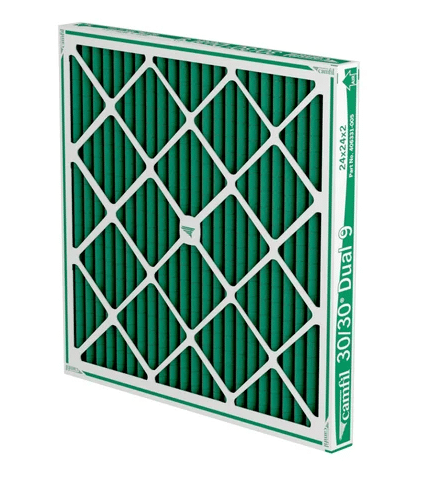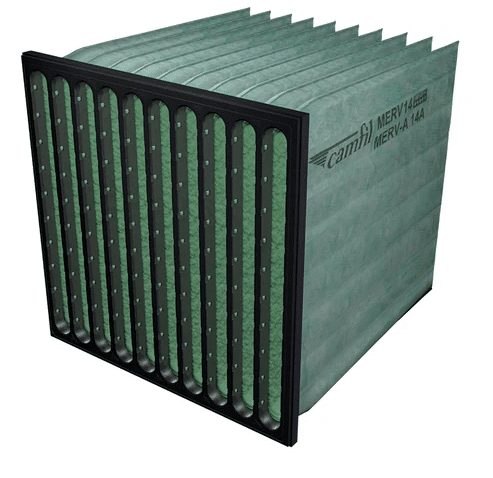Mechanical air filters are an essential component in most HVAC systems, providing cleaner air to employees in commercial buildings, students in schools, workers in factories, patients in hospitals, and more.
In this article, air filtration experts from Camfil explain the critical role of mechanical air filters in a variety of applications, discuss how air filtration efficiency is measured and published, explore the main types of mechanical air filters, and provide tips for choosing the best mechanical air filter for your building.
What Are Mechanical Air Filters?
The fabric portion of an air filter is a non-woven fabric constructed of various fiber sizes intertwined together in a random pattern to create a three-dimensional structure known as filter media. As air works its way through the maze of fibers, particles are captured and removed by well-established mechanical filtration principles, allowing cleaner air to exit on the downstream side of the air filter.
Particulate pollution, or particulate matter, is a term used to describe any solid or liquid particles suspended in the airstream. While the composition of particulate matter varies widely between different environments, small enough particles are known to be harmful to the human body, including the heart, lungs, brain, nervous system, and other vital organs and processes.
Filter Efficiency: HEPA, ULPA, and MERV Ratings
Not all mechanical air filters provide the same protection. The efficiency of a filter is determined by its ability to capture and retain particles of varying sizes. This is often measured in Minimum Efficiency Reporting Value (MERV) ratings, with higher numbers indicating better filtration performance. As discussed below, HEPA and ULPA indicate higher filter efficiency than filters rated using the MERV system.
HEPA Filters
HEPA stands for “high-efficiency particulate air” filter. An actual HEPA filter removes at least 99.97% of particles with a size of 0.3 micrometers from the air.
HEPA filters should be individually factory-tested to global testing standards to show that they are capable of delivering this level of protection. However, there is no official regulation of the term HEPA, meaning that companies can and often do claim that their products are ‘true HEPA filters’ without having the paperwork to back up the claim. Make sure the HEPA filter you choose is tested and certified with a label on it confirming factory testing and providing results. Be cautious of manufacturers unable to furnish documentation proving their air filters meet HEPA standards.
Learn more: HEPA Filters Explained — How Do HEPA Filters Work?
ULPA Filters
ULPA (which stands for “ultra-low particulate air”) filters are even more effective at removing particulate matter from the air than HEPA filters. ULPA filters remove a minimum of 99.999% of MPPS (most penetrating particle size) fine particulate matter with particles greater than 120 nanometers (0.12 micrometers) in size.
To clarify the scale of those particles, there are one million microns in a meter, and one thousand nanometers in a micron (therefore there are one billion nanometers in a meter). A human hair is, on average, 70 micrometers, or 70,000 nanometers, in diameter. The minimum particle size that ULPA filters can remove from the air is almost 600 times smaller than the width of a human hair.
The level of air filtration efficiency that ULPA filters offer is far more than is needed for most residential and commercial applications; even in most patient-facing medical settings such as hospitals, HEPA filters provide adequate protection. ULPA filters are primarily used in cleanrooms and other applications where complete sterility is required, such as manufacturing sensitive computer parts, batteries, pharmaceuticals, and medical equipment.
MERV & MERV-A Ratings
MERV is an acronym for minimum efficiency reporting value. The MERV rating and testing standard was initially developed in 1999 by ASHRAE, an international professional organization that offers guidelines and standards for HVAC-related technologies.
The MERV value indicates how effectively a filter captures particles within certain size ranges; when a filter is better at capturing smaller particles, it is assigned a higher MERV value.
To determine a filter’s MERV rating, particles of specific sizes are passed through a test duct onto the filter. These particles fall into three size categories: E1, E2, and E3. The filter’s effectiveness against all three size categories is evaluated against a MERV chart, and the final MERV rating is the highest value that meets all three requirements. For example, in order to achieve a MERV 13 value, the tested filter must be at least 50% efficient on dirt particles in the E1 range, at least 85% on E2 range and at least 90% on E3.
The highest MERV rating according to ASHRAE standards is MERV-16; it is important to be wary of filters claiming to have MERV ratings higher than that. Even the highest-rated MERV filter will not be as effective as an actual HEPA filter.
It is also essential to remember that a higher MERV rating isn’t necessarily always better. Air filters can feature an electrostatic charge that functions akin to a magnet, temporarily boosting particle capture efficiency across three size categories. This leads to a higher MERV rating for the filter. Yet, as the filter accumulates dirt, the charge loses its ability to draw in particles, causing the MERV rating to decline. For instance, a MERV-13 filter can decrease in particle capture efficiency long before it needs to be changed and match that of a MERV-8 filter, resulting in reduced protection for individuals and equipment compared to its original MERV-13 rating.
ASHRAE testing standards outline an additional method to assess filter efficiency devoid of electrostatic charge, producing MERV-A values. To differentiate between MERV and MERV-A, think of the “A” with “actual,” indicating that a filter’s MERV-A rating reflects its non-degrading filtration efficiency.
As is the case for HEPA and ULPA filters, MERV-rated filters should undergo factory testing to ensure that they are providing the level of protection for which they are designed. When purchasing a MERV-rated filter, your provider should provide the paperwork showing the results of these factory tests.
Types of Mechanical Air Filters
Panel Filters
Panel filters often serve as the only air filter in HVAC systems in commercial, and residential buildings. Elsewhere, they act as prefilters, safeguarding and prolonging the lifespan of more efficient and more sensitive final filters in a multi-stage filtration system. These filters protect sensitive equipment from larger particles, prevent higher efficiency filters from becoming clogged too quickly, and can provide some protection to our lungs from particulate matter depending on the quality and efficiency of the filter.

Example: Camfil’s 30/30 Dual 9
Compact Filters (V-Bank and Box)
Compact filters are used as final filters in industrial, commercial, and medical applications, providing better protection and long service life as part of a multi-stage filtration system than panel filters alone. They may also be used as prefilters in HEPA installations. Compact filters can withstand greater variations in airflow than panel filters and may be designed to withstand turbulence.

Example: Camfil’s Durafil ES3
Bag Filters
Bag air filters or pocket air filters can serve as prefilters or even as a single final filter. There are a wide variety of bag filters produced that are effective in applications ranging from indoor shooting ranges to food and beverage to data centers. While they typically have slightly less service life than V-bank filters, their design makes them far easier to transport and install.

Example: Camfil’s Hi-Flo ES
Considerations for Choosing the Right Mechanical Air Filter
When selecting the right mechanical air filter for your needs, various factors should be taken into account to ensure optimal filter performance, sustainability, and cost-effectiveness.
Pollutants
The size and type of particles you need to filter out, as well as determining whether or not you need a molecular filter to target gaseous pollutants, play a critical role in determining the appropriate filter. The geographical location of your site (including proximity to large roads, airports, and industrial processes) and pollutants generated within the building are both important considerations; for example, a bakery that generates large amounts of flour dust, which can damage baking equipment and cause contamination of products, will need different solutions than an office building.
Another related consideration is humidity; filters that will be housed in high-humidity areas should be made of materials that are designed to withstand deterioration, mold growth, and other potential issues from excessive moisture in the air.
The best way to assess current pollution levels is to consult with an experienced air filtration specialist, who can help you measure and monitor pollutants.
Application & IAQ Goals
Another important factor to consider is what your site hopes to achieve with new air filters. The level of filtration needed to protect HVAC equipment is different from what is needed to protect human health; furthermore, preventing the spread of airborne communicable diseases in a school requires a different approach to ensuring safe conditions in a hospital operating room.
Airflow Rate
Ensuring that the chosen filter can handle your system’s air volume without causing significant pressure drops is crucial for maintaining energy efficiency and preventing strain on your HVAC or other air filtration system. For high-turbulence applications, it is important to select a filter that is designed to withstand turbulent airflow.
Maintenance Requirements
Some filters are designed for easy replacement or cleaning, minimizing downtime and labor costs associated with their upkeep. Always balance upfront costs against long-term maintenance expenses and potential energy savings when making your choice.
Air Filtration Expertise
For advice specific to your site, please reach out to your local Camfil representative.
About Camfil Clean Air Solutions
For more than half a century, Camfil has been helping people breathe cleaner air. As a leading manufacturer of premium clean air solutions, we provide commercial and industrial systems for air filtration and air pollution control that improve worker and equipment productivity, minimize energy use, and benefit human health and the environment. We firmly believe that the best solutions for our customers are the best solutions for our planet, too. That’s why every step of the way – from design to delivery and across the product life cycle – we consider the impact of what we do on people and the world around us. Through a fresh approach to problem-solving, innovative design, precise process control, and a strong customer focus we aim to conserve more, use less, and find better ways – so we can all breathe easier.
The Camfil Group is headquartered in Stockholm, Sweden, and has 30 manufacturing sites, six R&D centers, local sales offices in 35+ countries, and about 5,600 employees and growing. We proudly serve and support customers in a wide variety of industries and communities across the world. To discover how Camfil USA can help you to protect people, processes, and the environment, visit us at www.camfil.us/
Media Contact:
Lynne Laake
Camfil USA Air Filters
T: 888.599.6620
E: Lynne.Laake@camfil.com
F: Friend Camfil USA on Facebook
T: Follow Camfil USA on Twitter
Y: Watch Camfil Videos on YouTube
L: Follow our LinkedIn Page
The post Everything You Need to Know About Mechanical Air Filters appeared first on Air Filters for Clean Air.
from Air Filters for Clean Air